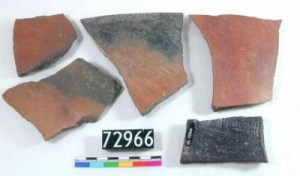7. Pottery Technology 1
| 868 Page: 74 of 418 Go To Page: | ◁◁ First | ◁ Previous | Next ▷ | Last ▷▷ |
7.11 Pottery in Archaeology
In the opinion of many, pottery was the earliest and most important invention by man. Certainly for historians and archaeologists it is the most significant artistic artefact, giving as it does clues to the social organisation, economy, cultural development, ritual and relationships with neighbours. Pottery has been called “the calendar of prehistory”. Broken pieces of pottery (sherds) are everlasting, and large quantities exist wherever man has settled – either broken during production or later during use. Some complete items are found, mainly in tombs and graves. In any archaeological excavation pottery sherds are likely to be the most common item unearthed. Until the end of the 19th century, these excavations mainly extracted artefacts rather than relating them to their surroundings. The great step forward was made by a British archaeologist, Sir W. M. F. Petrie. In 1880, aged 27, he began 40 years of surveys and excavations in the Middle East, especially Egypt. His discovery of painted pottery at sites in the Nile Delta proved they had been trading colonies for the ancient Greeks. This discovery led him to believe that history could be reconstructed by a comparison of potsherds at various levels of an excavation. His excavation in Palestine and Heinrich Schliemann’s at Troy were the first two “stratigraphic” studies. It soon became evident that potsherds were ideal for dating layers in an excavation. Analysis of the residual content inside vessels can also indicate use.
Carbon 14 dating can be used for organic matter associated with the item, so it can be used by archaeologists during excavations for dating pottery. However, there are significant discrepancies in dates cited by different authors, depending whether they are using standard C14 dates or calibrated ones based on other measures such as dendrology (tree rings). Unfortunately these differences are of the order of 1,000 years at 5-10,000 BC. Where possible in this work calibrated dates are cited.
As an example of the use of pottery in archaeology, it recently solved a conundrum in the Nile Delta. The city of Rameses II, Pi-Ramesse, was discovered with many major items intact, but all the pottery was dated to at least 200 years later than its known founding date – where was the missing earlier pottery? Using pottery fragments from settlements in the Nile Delta, models were made of its major tributaries when Rameses II would have been alive, which led to the discovery of the original city foundations (and its associated sherds) some considerable distance from the present site. Because the route of the major tributary supporting the city changed, Pi-Ramesse was abandoned, but later, 200 years after the reign of Rameses, the entire city, including major buildings (but not including the pottery sherds), was relocated to its present site, explaining the dating anomaly.
The decoration on pottery can provide a great deal of information on current affairs, lifestyles and social background as well as recording specific events such as battles and invasions.
However, the source of the subject matter used in decoration can also be complicated. As an example, a recently discovered Limehouse soft-paste porcelain model of “the Old Vice-Roy of Kanton” was derived from an earlier Whieldon Creamware model that was in turn copied from a Dutch engraving of 1655 – many designs are derived, modified and passed on.
The problem of attribution of unmarked wares to certain factories is illustrated by research undertaken at the Limehouse site in London in 1990, prior to the construction of a new road. Excavations revealed blue on white decorated porcelain wasters (sherds) that have led to a reattribution of items made between 1746 and 1748 from Liverpool to Limehouse. Similar excavations at Vauxhall and Isleworth have also indicated reattribution of the somewhat later pieces to these potteries from Derby, Bow and Lowestoft. Another example is Liverpool, as apart from being a major port, it had a number of potteries in the 18th century, and matching unmarked wares to individual Liverpool factories is a difficult task, although recently there has been some clarification. Some British porcelain wares from this era still await definite attribution.




